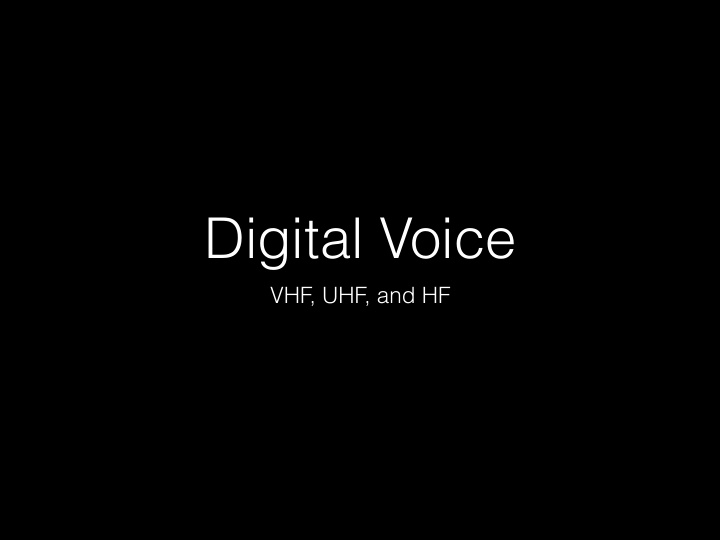



Digital Voice VHF, UHF, and HF
Analog Voice - AM/SSB
Analog Voice - FM
Digital Voice GMSK UHF 4FSK VHF C4FM AMBE, AMBE+2, Codec-2 HF OFDM Audio Vocoder Modulator Integrate data into protocol A/D Compressed 10101111010 Mic Microprocessor Amplifier Codec Binary Data Converter Speaker Demodulate Strip data from protocol D/A Decompressed Convert to digital data -compress data for txmit. Re-creates audio from received data stream. Received Digital Voice DSTAR Extraneous noise is stripped from signal. Binary data only is used to recreate voice - no noise - normally. As signal strength decreases or when phase shifting- occurs, eventually the data stream fails at low S/N. DMR Each mode has a different way of handling Data stream failure: DSTAR - do your best - R2D2 - poor re-sync Fusion DMR - silence the audio - No R2D2 - good re-sync Fusion - Silence the audio - good re-sync de WA3PNY
DSTAR
Brandmeister DMR 3100 - USA Wide Brandmeister Regional Talk-groups 3142 PA State Wide
Yaesu C4FM Wires-X Wires-X segmented into rooms on node computer
DV Voice Modes - Networking Characteristics • D-STAR • User control capability –substantial • Networking options – G3, D-Plus (REF), DExtra (XREF), DCS, XLX, ircDDB, (Echo - end to end loop) • Innovation ability – many efforts and accomplishments (DV Access Point and DV Hotspots, XREF, DCS, XLX) • DMR • Centrally controlled structure – inflexible (top - down) • Networking options: c-bridge, Hytera • Innovation ability – somewhat limited (4 networks: DMR-Marc, Hytera, DV4mini, Brandmeister) • Fusion • Yaesu controlled servers – inflexible • Networking options – WIRES-X , DV4Mini Reflectors, MMDVM YSF Reflectors • Innovation ability – limited, but just beginning - Links to DV4Mini Reflectors , Latency Concerns
Is DSTAR Legal on HF? Sec. 97.307 Emission standards (<29.0 MHz) • (f) The following standards and limitations apply to transmissions on the frequencies specified in Sec. 97.305(c) of this part. • (1) No angle-modulated emission may have a modulation index greater than 1 at the highest modulation frequency (Angle Modulation = FM, PM) . (MSK is binary digital FM with a modulation index of 0.5.)1 • (2) No non-phone emission shall exceed the bandwidth of a communications quality phone emission of the same modulation type. • The total bandwidth of an independent sideband emission (having B as the first symbol), or a multiplexed image and phone emission, shall not exceed that of a communications quality A3E emission (amplitude modulation telephony, double sideband) . • (3) Only a RTTY or data emission using a specified digital code listed in Sec. 97.309(a) of this part may be transmitted. • The symbol rate must not exceed 300 bauds, or for frequency-shift keying, the frequency shift between mark and space must not exceed 1 kHz. 1 - “GMSK in a nutshell” - https://www.researchgate.net/publication/2575678_GMSK_in_a_nutshell, by Thierry Turletti
HF Digital - A Look Back • 2005-2008 - Early work with FDMDV, DRMDV, and WinDRM; all used Melp Codec, an effective low bandwidth codec for HF. • Melp was developed by US DD, and NATO, but was held by several private companies as licensed software. • The Codec was initially OK for amateur use, but was pulled due to licensing concerns. • That left AOR as the only effective HF Digital Voice application (hardware 2.5 KHz). • Hams hoped that a replacement would be developed as an open source, but nothing was produced for years.
HF Digital with Codec-2 • 2015, an international group of amateurs was successful in developing Codec-2, allowing speech to be compressed to 700-1600 bps, in a 1.25 KHz bandwidth. • 2016, FreeDV (based on FDMDV), was developed as a software HF DV transceiver using a PC/Mac. Sounds as good as Melp, theoretically allows 2 digital qso’s in the bandwidth of a SSB signal. • FreeDV was coded by David Witten (GUI, architecture) and David Rowe (Codec 2, modem implementation, integration). It is currently being maintained by David Rowe. • February 16 2017 : Ver 1.2 of FreeDV GUI program with 700C - speech quality close to FreeDV 1600 with greatly improved low SNR performance. FreeDV 700C is approaching SSB in it's low SNR performance. • FreeDV 1600 affords near FM sound when SNR is high.
Current HF DV Modes • HF DSTAR - 6.25 KHz bandwidth - IC-9100 & IC-7100 or ( GMSK Node Adapter with HF Rig with 9600 packet ) HF DSTAR HF DSTAR QSO Finder • Yaesu Fusion - 12.5 KHz bandwidth - FT-991 ( above 28.8 MHz ? ) HF Fusion • AOR - 2.5 KHz bandwidth - ARD-9800 or ARD-9000 AOR QSO AOR Raw • FreeDV - 1.25 KHz bandwidth - Software solution FreeDV Site FreeDV QSO Finder
Recommend
More recommend